Intro & Disclaimer
This has been the most difficult story to write up to now. Emotionally, content-wise and also for privacy reasons.
When I asked people for their permission if I could tell this story, they unanimously agreed, but with the same breath they asked me Please do not tell my name. They think that nobody knows about what is happening in some regions in Myanmar, that nobody in the world cares. And they may be right to a large extent.
I have never attempted to write about a political conflict, and even more so not in a country I know so little about like Myanmar. However, to understand the background, it is vital to know a little bit what is going on. One day in the mountain villages surrounding Hsi Paw in Myanmar’s Shan state has allowed me to peek behind the veil. And when I see things, I ask questions, want to understand and be able to put things in perspective.
I am well aware, that this is walking a tightrope: I do not want to put anyone at risk, and at the same time I do not want to tell a naïve kindergarten story about a very complex, highly opaque and continuously changing political situation. I googled and read a lot in the past days, but trustworthy information is scarce.
So it has taken me a while to put together the pieces of what I have seen and experienced during a trip to the mountains in Myanmar’s Shan region, and the information I could gather about it. The names are changed, and again, I would like to stress that all factual information given here is available in the public domain.
I had never been to a region with an ongoing armed conflict. Where armed forces patrol forests and remote places to secure and expand territories. Where shootings occur regularly and fighting lines are unclear.
I did not expect to go to such an area, when I organized a 1-day trip to the villages in mountain regions surrounding Hsi Paw – a larger town with some 180.000 inhabitants in the North-East of Myanmar.
Until 1962 it was a royal city and from an Austrian perspective it is worth a side note that the last princess and wife of the last ruler of Shan state was born as Inge Eberhart in Carinthia in 1932. She met her future husband as an international student while in Colorado, and when they got married she had no idea of his background. Only when arriving in Burma after her graduation, she realized that her husband was the heir of the throne of Shan state. She became Mahadevi Inge, learned to speak Shan and Palaung and was soon highly respected by the people because of her social engagement. A true fairy tale with a bad end. Inge is 86 years now and lives in the US. The disappearance of her husband and father of her two children, following his arrest in the course of a military coup in 1962 has never been clarified. Her memoir Twilight over Burma was published in 1994.
Hsi Paw was one of the few places in Myanmar, where people did not think that I lived in the land of kangaroos, when I told them where I came from.
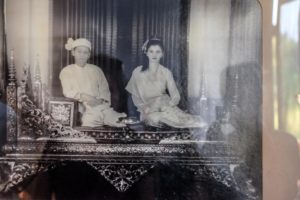
Early October mornings around Hsi Paw region are mystic. Thick clouds cover the fields like in cotton batting at dawn. A light jacket is a good idea, but the sun quickly warms the air and from the terrace of my hotel I could watch outlines of trees, rice fields, pagodas, houses, human silhouettes and sounds gradually emerging from the fading blue-grey. Mid-October is still pre-season, so there were not too many guests in our hotel and our waiter, Anthon, was sometimes standing at our rooftop terrace to look at the scenery. Then he turned around to me, smiling all over his face: It is so beautiful. He has been learning English for 4 months only. As he brings me a cup of green tea from the mountains this morning, he doesn’t say Mingalabar like his normal Good morning-Hello to me, but he says something else. You go to mountains today, yes? He gives me a crash-course how to say Hello in the Palaung villages (jam-sa) and in Shan language (Ma-y Sung Kha). The villages we are going to visit today are inhabited by two different ethnical groups, who speak a distinct language of their own, which is also very different from the official Burmese language.
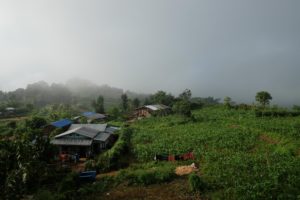
When my guide, let’s call him Mike, picked me up after the breakfast, I felt well prepared for a day of touring around the countryside. The usual safety precautions: rain jacket, sunscreen, water, hiking shoes, no helmet. Off we go in the morning sun!
Benzinbrüder 2.0. Our first stop for morning tea after about a one-hour drive was in a small Shan settlement consisting of maybe 10 houses. We had tea and green melon in the shade of one of the usual small village shops. The pastoral calm was suddenly unduly disrupted when a young father on his motorbike was trying to bring his 1-year old daughter on his arm to sleep. Look! You will see, when he stops the bike, she will start to cry, said my guide already knowing what was going to happen. Roland Düringer’s Benzinbrüder immediately crossed my mind – she would have been the star! The little girl in her baby pyjamas obviously loved the sound and vibrations of the bike, combined with the gasoline aromatherapy for her Dream Baby Dream ritual. In order not to put her at any health risk, her father put her in a wrap-around baby carrier and took an umbrella in his left hand to protect her from the morning sun. In this setup he was driving around the village rocking her gently, and she was fast asleep when they returned some two minutes later. Not long though, as she was smart enough to immediately realize when her proud dad switched off the motor. Her grandma then took over and resolved the situation in a confident way, like all grandmas of this world do. A first-class Gasoline Sister in the making. (and I do avoid all comments from a health perspective here haha)
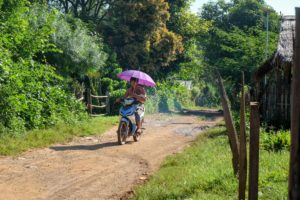
While curiously looking around, 2 signs on the wooden posts of the shop caught my attention. The first warned that All tourists must be accompanied at all times by local guides.
The second one was a panel from the Global Fund for Malaria and Tb – a public-private partnership and one of the biggest international financing organizations in the fight against AIDS, Malaria and Tuberculosis.
I asked about Malaria (while discreetly checking, if I had put the repellent in my bag). Yes, there were Malaria cases around the area. Not many now, but some years ago, 4 or 5 people died due to Malaria in some villages every year. The situation has much improved due to the distribution of insecticide-treated bed nets and artemisinin-based combination therapy and – importantly also – an information campaign, educating people about symptoms, which require immediate professional treatment.
And Tuberculosis? Yes, also. The world’s biggest killer in infectious diseases, the poverty disease. In Myanmar 525 per 100.000 population are infected with Tb, 4 times higher than global average.
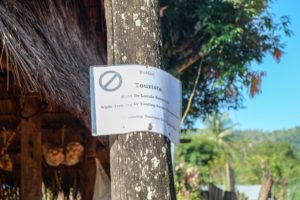
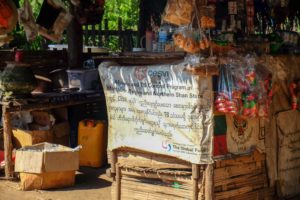
Mike explained his plan for the day to me and added a little disclaimer: he was not sure, if we could take the big loop, or if we might need to turn around at some point due to some conflicts in the area. There will be military around. … aha, ok. Burmese military? No, they don’t come here. If they come here it will be very bad, they will fight.
First chunks of information. Oh, yes, I remembered that my guidebook had 2 or 3 lines about the Shan State Army, who was active in this area, advising that tourists should get latest information from official guides on the actual situation before trekking in the area.
My guide has grown up in a Palaung village in the mountains, many hours away from here. He told me that 200 families with around 800 people were living there before the outbreak of the present conflict. When the situation escalated, he was newly married, their baby-girl was one year old. The military groups are recruiting young men from the villages to join their fight. In my village there were no volunteers. They made a lottery, who of us should join the fighting groups. 7 days after the lottery I left. He was one of the few who spoke English, thus making him a highly attractive target to recruit, as he could be sent to a training camp across the Thai border to acquire basic medical skills and would then serve as a field doctor. But I am a farmer, not a doctor, not a soldier. He was the first one to leave his village, many others followed – leaving their farm, animals, houses and lives back. The pressure on the remaining families is growing.
After our first stop I had more questions than information, and it all seemed very unreal for me. Some crazy war, some ethnical conflicts of which there are so many in this world. I told him that we hear about the Rohingya crisis in Europe, but I had to admit that I had not been aware of these local conflicts.
There are 135 ethnical groups living in 7 big states in Myanmar. And there is peace in only 2 states! Many smaller and large regional conflicts began after former Burma gained independence from Britain after 1948. The civil war in Myanmar – which are in fact many regional conflicts – has been going on over 70 years now and has thus also been labelled as the world’s longest running civil war.
And guess why? – it is about power, land and natural resources. Myanmar is a country incredibly rich in natural resources like gold, silver, rubies and jade, natural gas, petroleum or timber – a blessing and a curse. Not so long ago, conflicts were also revolving around dominance in drug business, mainly opium.
For many years and up to now the Myanmar Armed Forces – Tatmadaw – has had very good reasons to keep these conflicts up and running, heating up and cooling down in circles. Despite the democratic revolution, the military is still the critical power in Myanmar. In the new constitution of 2008 they have secured themselves a permanent 25% of all seats in parliament, in addition to the ministries of home, border affairs and defense, and one of the country’s two vice presidents. In my interpretation this means that with Myanmar’s young and proliferating democracy, the military will remain THE key power player in the country also in the future.
And all the armed conflicts inside the diverse country just come in handy as a raison d’être, a rationale to claim power, people, budget and influence. See, we need to be everywhere, we need to control the country.
Community involvement in the peace building process is largely hindered, for example by limiting any political gatherings to 20-30 attendees.
And while “the Lady”, State Counsellor Aung San Suu Kyi, is meeting with all the tribal heads to negotiate cease-fire and peace, the military is the game-maker and puppet-player in the fore- and background. The Asia Times has recently summed up that “the government’s peace process is [a] cover to sustain conflict and sow divisions among ethnic armed groups.” in an article titled ‘Peace is war in Myanmar.’
We don’t hear a lot about this in Europe. Why? Because it’s just one of the manifold crises in far-away countries, because it is mainly internal conflicts, and you may be a rogue to think that some similar power mechanisms (though of course not identical in shape) are currently being used extensively all over the developed world to sow divisions among the population as well.
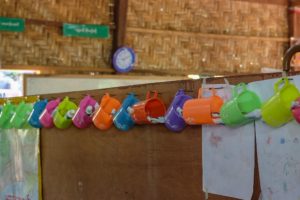
We continued our trip to the next Shan village, which also hosts a school and kindergarten. Some children were writing exams, so we tried not to disturb them. Colorful mugs with toothbrush and toothpaste are hung up next to posters with animals, the world map and letters. Kids in Myanmar learn both, the Burmese and Latin alphabet right from the beginning. And they learn to speak their language plus the official Burmese language.
Our path gets steeper and more challenging to drive as we continue our way up. It had rained heavily for some days before and the red road is charged with deep, dried-out cart tracks. In his previous life Mike had been driving loads of 100 kilograms of tea to from his village down to the market, he is very diligent in navigating the bike through the dried, hard mud roads. Several times I offered to get off the bike and walk, but most often he would just reply: No problem, you can keep the balance, the tea could not. When we fell with the bike, we could not get up anymore. We were always going together.
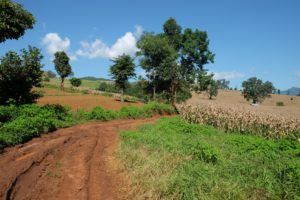
Small family subsistence farms, fields with corn, mountain rice, cereals, vegetables, tea and chillies are seeming our way, painting beautiful rural landscapes until merging into endless forests in the mountains. It seems that agriculture is largely still very fragmented and diversified, going with the season, and that the big agro-companies have not yet moved in on large scale. The landscape is delightful and seems healthy wherever I turn my head. You know, the villagers often ask me: What do we have? We are not rich. Why are tourists coming to visit us? I tell Mike that I see a lot of richness and things to preserve here, and I see a big chance for sustainable development in Myanmar. Despite all my logic I will always be a dreamer.
As it is practically impossible to convey the beauty of the changing landscapes by words only, I have compiled a short video of the day. (please click blue text)
A deserted snack station and a lonely tom cat
We pass by a place that used to be a small snack station in happier times. 3 deserted wooden tables, benches, a place to heat food. There are not a lot of tourists this year, the shop owner had shut down his enterprise and left the place. I hear a cat moaning and we find him sitting under the small deserted hut. Mike told me that he has stayed in his home up here when his family left. The red and white striped guy looked well-fed, the fields and forests obviously provisioned him with mice and other delicacies, but he seemed a bit lonely and missing some human company. He kept complaining, but was clearly happy for some short distraction and caressing.
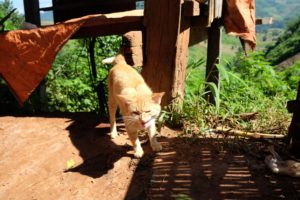
We climb up further, vegetation and geology gradually change, the muddy roads are now covered with sharp-edged limestone pieces. A beautiful baby snake hides along the side of the path before a huge, old Banyan tree indicates that we have reached our next destination, the first Palaung village on our way, where we would have lunch. Also here we are happily welcomed, Mike seems to know practically everyone in the village.
We park the bike in the courtyard of a family house with annexes, and are being offered tea in the large, low-ceilinged multi-purpose living space. It’s a busy day, villagers come and go, they are bringing rice for the upcoming festival, the donations are collected in big bags and carefully noted down in a book. Colourful Chinese posters decorate the wooden walls, clothes are hung below the stairs leading up to the first floor, cupboards are jam-packed with loudspeakers and other seemingly not used hardware of all kind.
The men are exchanging news. I get up and join the lady of the house and 3 cats in the kitchen. I sit down on the steps leading to the dim, homey room with an open wooden fire in the corner. Our host is sitting on a 10cm high wooden footstool and is cleaning and cutting vegetables and green leaves for lunch. She pours more tea, and then sets up a pot to cook rice. The open fire smells wonderful, it is very cozy, just sitting here with a purring cat on my lap. It is a classical head and heart-split: I know that these open cooking fires are contributing a lot to lower respiratory infections, and increased mortality in children under 5 years, but it is an atmosphere that just smells and feels like home.
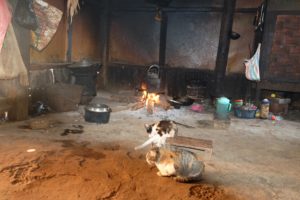
While lunch is slowly boiling, we take a walk through the village. People are busy in their gardens, on the field, drying fermented tea, collecting flowers, cleaning and preparing the village for the upcoming Festival of Lights on Oct 24. A bunch of children is playing on a grassy plot, two girls with running noses are busy with a machete and a Stanley knife, cutting greenery or drawing signs into the ground. We sit down with them, joke around. The boys especially adore Mike, who has a lot of fun with them. One of the older boys is taking pictures with my camera, the smaller girls find this very funny and can’t stop giggling.
We are again invited for tea in another house, which is also homestay. The brew is hot, strong and bitter, the cups swim in bowl with a light brownish water. I accept politely. Mike has left for another chat with the neighbours and so I find myself alone with the family. We talk a bit with hands and feet. One of the sons smokes a cigarette with the help of a dangerously gurgling water pipe, that looks and sounds very spooky. The parents smoke the local cigars. Our visits seem to be welcome breaks during the work on the fields and in the village.
Returning to our starting point, a delicious vegan lunch is ready: rice, fermented tea leaf salad, beans, roasted peanuts, pumpkin leaves, soup.
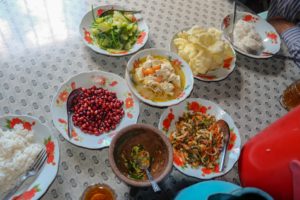
I don’t wait for entre la poire et le fromage for the difficult topics this time, but ask a lot of questions as soon as we are sitting down. The picture becomes more dense and at the same time more confusing.
There is Palaung military and Shan military, and there a large splitter groups, various rivalrous groups within these forces. What a chaotic picture! More and more it becomes clear to me, that this is not an ethnical conflict. It all reminds me much more of Mafia clan-like conflicts. Both, people in Shan and Palaung villages are equally afraid of all military groups, no matter from which side. On a very broad level they are anxious of being molested, recruited, of violence they don’t want to engage in. Many of them speak both languages, they know each other, are friends, and nowadays mixed marriages between Shan and Palaung people are more and more common. Does this look like an ethnical conflict? Not to me.
After a good pause, we drive further up into the mountains through temperate pine and mixed forests, my altimeter soon shows 1300 meters. The landscape is getting even more beautiful, forest covered mountain ranges as far as I can see, far down below rice terraces sparkle in bright green.
Every now and then I get off the bike and walk, due to the bad condition of the path. But most of the time I sit behind Mike, am hardly able to conceive all the beauty around us and take pictures while driving, shooting from the hip.
And suddenly after a turn of the path there it is. A white-red bar blocking the road, a Shan State Army South camp right beside it. The SSA-S is the armed wing of the Restoration Council of Shan State (RCSS) and one of the largest insurgent groups in Myanmar.
Don’t take pictures! Mike hisses through his teeth. 2 young boys, hardly 17, are sitting in a wooden shack. We need to register and get off the bike. Mike speaks with them in Shan language, explains where we plan to go, he stays true but a bit vague in his information. They want to know my details. I put my naïve, blonde, friendly tourist face on – Shall I write down my name? It is a bit hard to spell – blondie smile. Honestly, I could have written Bibi Blocksberg in this column, they don’t want to see a travel document (and I wouldn’t have one with my anyway). What is the next column – the one with the numbers? Another dutiful, slightly stupid foreigner smile. Ah, age, haha! I note down 50, don’t look at their faces. Still many people die at this age here. Then a cross on the F-side of the M / F-column. I leave the other columns blank, step back politely. They yell over some information to a green plastic tent, where the commander of the station holds out his head. I am silently glad that he could not have seen me taking the photo before. Shouting back and forth. It seems to be OK to pass. Mike indicates a barely noticeable side-wards move with his head. We can get on the bike and proceed. We drive off. Ooookay …. Only a few hundred meters later we arrive at the Palaung village we wanted to visit.
It is our Anthon‘s, our waiter‘s, village. As promised, I take a picture of his former family house, which is now deserted, doors and windows boarded up. We have tea in a place nearby, which is a bigger house of a seemingly once powerful family. Everything is tidy, there is a little shop inside, in better times it also used to be a homestay for visitors.
Our host, let’s call her Auntie, is a decided, strong lady. She serves tea, and then sits down in a chair behind my back and starts to tell. No Hollywood regisseur could have placed her more exposed and prominent there. I am attentive, but don’t turn around completely, because I suppose that she had her reasons why she wanted to sit there. After a while she gets up, moves to the small desk on the other side, where I can see her now. During the conversation she changes places 4 times, and although I cannot understand what they are talking, it is obvious that it moves her. Mike will say in the evening: It hurt me what she was saying.
She tells of the families that have already left the village. The soldiers normally leave them in peace, but of course the villagers must pass the checkpoints every time they leave the village. Sometimes the armed men come to the village to gather food and other stuff they need. I don’t see a single young man in the villages.
The paramilitary squads have cut down the trees on top of the mountain ridges, to allow a good overview of the area, which they control. When looking around I can detect them now in all directions. There are not even natural resources in the area we are in, but the soldiers are there around the clock, intimidating the people.
The more I read about it later, the more it seems that some armed groups with blurred conflict lines are playing wargames on the back of civilians, who have no interest in these fights. Village people and farmers cannot send their kids to school properly, have no access to decent medical services if needed. Families who are being molested and observed in their village 24/7 – a complete madness. This is anything else but an ethnical conflict in my humble opinion.
On our further way, every now and then fighters in Rambo-like outfits pass by, carrying AK47 machine guns on their back. We greet friendly, sometimes Mike exchanges some words. Normally you should jump off the bike, politely take the Kalashnikov rifles out of their hands and tell them to please stop that nonsense immediately.
The sun is already descending, as the next turn opens a breathtaking view over mountain ridges as far as the eye can behold. I jump off the bike to take a quick picture, but Mike says: I meet you up there, just follow the path. This is the village I wanted to take you to.
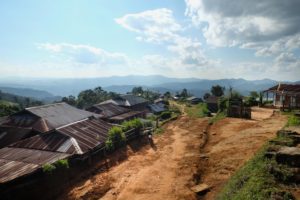
There are these rare and prescious moments where I realize that I am in the middle of a picture frame that I have had inside my soul forever. This is one of the main reasons why I travel. This is paradise.
We are at 1600 meters altitude, there are houses on both sides of a mountain ridge. A red-soil path leads through the village directly into the West, where the late afternoon sun is soaking the landscape in orange and yellow. I have a homestay here, 3 years ago I could still take guests up here. Women and children are cleaning the path from grass, they pimp up the village for the upcoming Full Moon Festival of Lights as well. They notice us, but continue their work, just the children come and try to greet us in English: Good-bye, good-bye waves a girl, who must be around 4 or 5 years. We laugh and say Hello. She replies with Good-bye again. Two boys are climbing up the steep bank of the path to where we are standing. I walk over to the group and ask, if I may distribute some Ricola sugarfree candies to the kids. Yes, I may, more and more children dare to come closer, also some of the mums want to taste, and so we share my complete stock. They decide to take a break, sit down all together on the bank. It is incredible. This is one of the most beautiful places I have seen. I am at the verge of crying. So peaceful here, villagers working together, children helping or just staying next to their mums. A school, a monastery, a place to play Takraw, which looks a bit like a beach volleyball place.
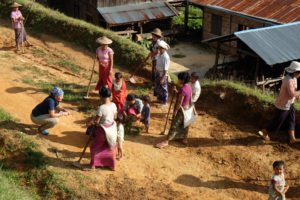
After a long while, Mike gently puts an end to my alpha state and beatitude: If we can get through the next checkpoint we can really go the big loop, then we don’t need to go back the way we came. We are lucky, the 2 young recruits lift the bar without big fuss and let us pass.
We take the long way home, the sun sets incredibly beautiful over corn- and rice fields framed by sunflowers borders as we descend. A river sparkles in the plain below – the whole area strongly reminds me of the peaceful Wachau region around river Danube in Austria. I would not have been surprised to find vineyards around the next corner.
I am full, with pictures, stories, emotions. No more. I know that I will need some days to digest everything I have seen, give me soul time to catch up.
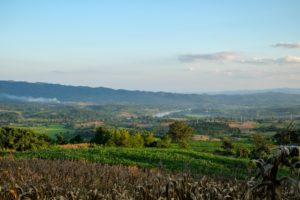
I read a lot about the background in the next days, and more and more I understand that this is not only a phenomenon within Shan State, but is happening in one way or the other across large areas of Myanmar.
A frightening reality, which I was not aware of. Not frightening for me as a tourist, but for the people, families and kids living in this madness day by day. Enduring an “ethical conflict”, which is not theirs. Living between the lines of paramilitary groups fighting for power and influence. Hiding their boys again and again to prevent them of being recruited.
What can be done? The answers are complex and moving target. And everyone I asked just shrugged their shoulders, remembering much better times. They want that their struggle is heard and seen.
What can I do? Even less, as much as this is uncomforting. Probably as much as I can do to end mafia wars in Southern Italy.
On the evening of the Full Moon Festival of Lights I made a promise that I will return to the village high up on the mountain ridge and stay there to see the sun rise over the clouds. Return when there is peace again, when the military, that doesn’t belong there, has left again. And I will stay overnight and watch the sun go down behind the mountains. I will light candles, sit with the moms and have tea, play with the kids and go to bed early. In order to be up when the sun rises on the other side of the village. I want to sit there and watch the sun warm away the thick clouds and the fog covering everything that lies below. I will sit there in peace and see the sun rise to a new day.
Promised.
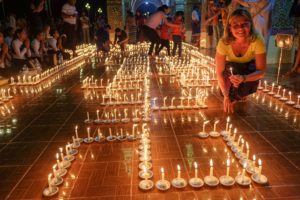

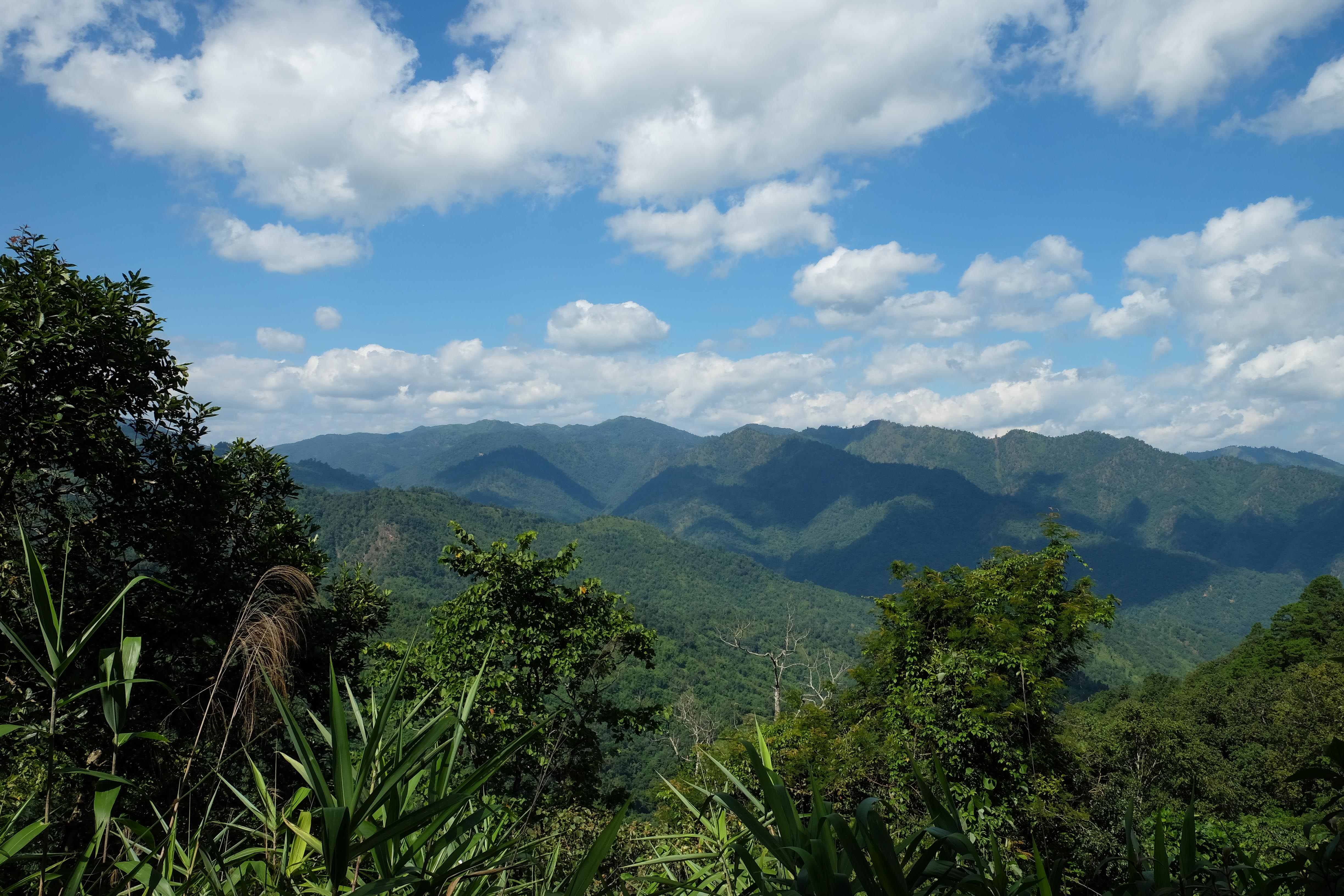
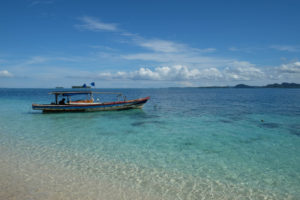

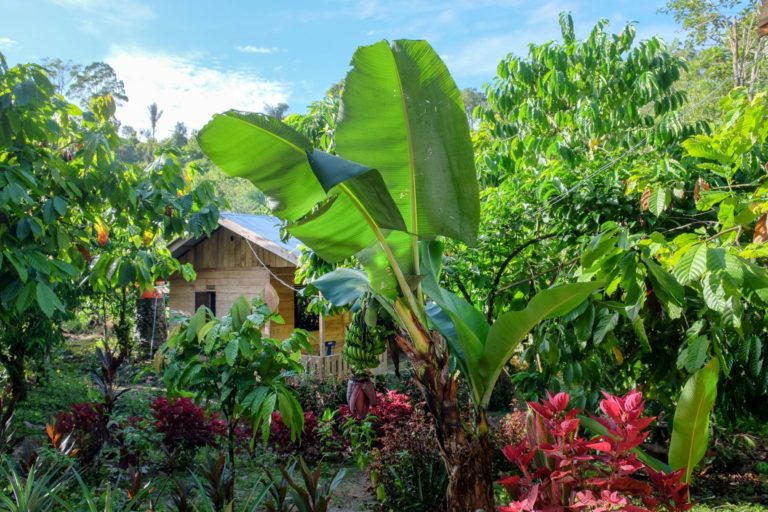
Dagmar
15 Nov 2018❤